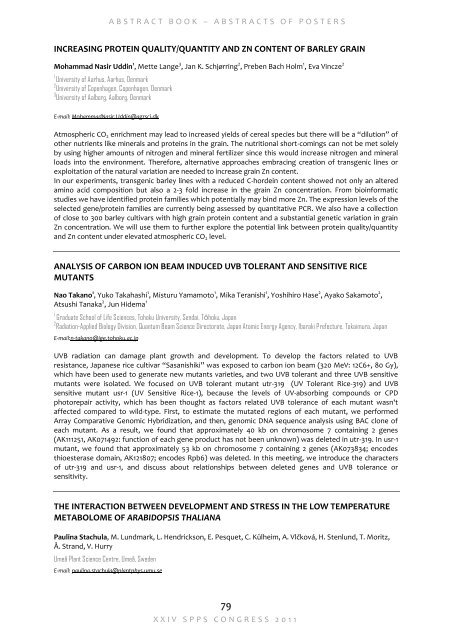1. Front Cover.cdr - CORE
1. Front Cover.cdr - CORE
1. Front Cover.cdr - CORE
You also want an ePaper? Increase the reach of your titles
YUMPU automatically turns print PDFs into web optimized ePapers that Google loves.
A B S T R A C T B O O K – A B S T R A C T S O F P O S T E R S<br />
INCREASING PROTEIN QUALITY/QUANTITY AND ZN CONTENT OF BARLEY GRAIN<br />
Mohammad Nasir Uddin 1 , Mette Lange 3 , Jan K. Schjørring 2 , Preben Bach Holm 1 , Eva Vincze 2<br />
1 University of Aarhus, Aarhus, Denmark<br />
2 University of Copenhagen, Copenhagen, Denmark<br />
3 University of Aalborg, Aalborg, Denmark<br />
E-mail: MohammadNasir.Uddin@agrsci.dk<br />
Atmospheric CO2 enrichment may lead to increased yields of cereal species but there will be a “dilution” of<br />
other nutrients like minerals and proteins in the grain. The nutritional short-comings can not be met solely<br />
by using higher amounts of nitrogen and mineral fertilizer since this would increase nitrogen and mineral<br />
loads into the environment. Therefore, alternative approaches embracing creation of transgenic lines or<br />
exploitation of the natural variation are needed to increase grain Zn content.<br />
In our experiments, transgenic barley lines with a reduced C-hordein content showed not only an altered<br />
amino acid composition but also a 2-3 fold increase in the grain Zn concentration. From bioinformatic<br />
studies we have identified protein families which potentially may bind more Zn. The expression levels of the<br />
selected gene/protein families are currently being assessed by quantitative PCR. We also have a collection<br />
of close to 300 barley cultivars with high grain protein content and a substantial genetic variation in grain<br />
Zn concentration. We will use them to further explore the potential link between protein quality/quantity<br />
and Zn content under elevated atmospheric CO2 level.<br />
ANALYSIS OF CARBON ION BEAM INDUCED UVB TOLERANT AND SENSITIVE RICE<br />
MUTANTS<br />
Nao Takano 1 , Yuko Takahashi 1 , Misturu Yamamoto 1 , Mika Teranishi 1 , Yoshihiro Hase 2 , Ayako Sakamoto 2 ,<br />
Atsushi Tanaka 2 , Jun Hidema 1<br />
1 Graduate School of Life Sciences, Tohoku University, Sendai, Tōhoku, Japan<br />
2 Radiation-Applied Biology Division, Quantum Beam Science Directorate, Japan Atomic Energy Agency, Ibaraki Prefecture, Tokaimura, Japan<br />
E-mail:n-takano@ige.tohoku.ac.jp<br />
UVB radiation can damage plant growth and development. To develop the factors related to UVB<br />
resistance, Japanese rice cultivar “Sasanishiki” was exposed to carbon ion beam (320 MeV: 12C6+, 80 Gy),<br />
which have been used to generate new mutants varieties, and two UVB tolerant and three UVB sensitive<br />
mutants were isolated. We focused on UVB tolerant mutant utr-319 (UV Tolerant Rice-319) and UVB<br />
sensitive mutant usr-1 (UV Sensitive Rice-1), because the levels of UV-absorbing compounds or CPD<br />
photorepair activity, which has been thought as factors related UVB tolerance of each mutant wasn't<br />
affected compared to wild-type. First, to estimate the mutated regions of each mutant, we performed<br />
Array Comparative Genomic Hybridization, and then, genomic DNA sequence analysis using BAC clone of<br />
each mutant. As a result, we found that approximately 40 kb on chromosome 7 containing 2 genes<br />
(AK111251, AK071492: function of each gene product has not been unknown) was deleted in utr-319. In usr-1<br />
mutant, we found that approximately 53 kb on chromosome 7 containing 2 genes (AK073834; encodes<br />
thioesterase domain, AK121807; encodes Rpb6) was deleted. In this meeting, we introduce the characters<br />
of utr-319 and usr-1, and discuss about relationships between deleted genes and UVB tolerance or<br />
sensitivity.<br />
THE INTERACTION BETWEEN DEVELOPMENT AND STRESS IN THE LOW TEMPERATURE<br />
METABOLOME OF ARABIDOPSIS THALIANA<br />
Paulina Stachula, M. Lundmark, L. Hendrickson, E. Pesquet, C. Külheim, A. Vlčková, H. Stenlund, T. Moritz,<br />
Å. Strand, V. Hurry<br />
Umeå Plant Science Centre, Umeå, Sweden<br />
E-mail: paulina.stachula@plantphys.umu.se<br />
79<br />
X X I V S P P S C O N G R E S S 2 0 1 1


